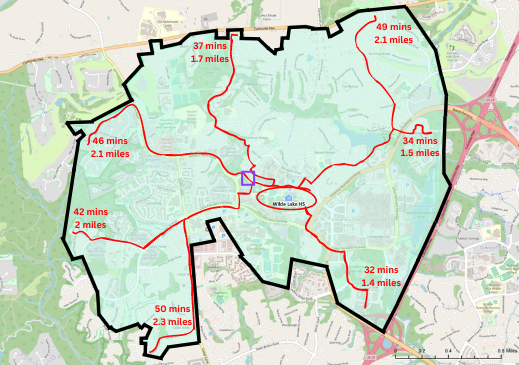County Expands Walk Area to Two Miles

The walk area map for Wilde Lake shows that some students will have to walk up to 2.3 miles, or 50 minutes to school starting in the 2023-24 school year. This change is in response to the bus driver shortage that hit in the 2021 school year. MAP FROM HCPSS
Next year, any student living within a two mile radius of Wilde Lake will walk to school. Students along the boundary may face walk times up to 50 minutes, according to Google Maps.
The decision to expand walk areas was a response to the bus driver shortage that hit at the start of the 2021 school year. The shortage led to students being transported in shifts. With the implementation of the new walk areas next year, less bus drivers will be needed to transport students.
The change sparked county-wide protests from parents and community members.
The non-transportation areas create an issue for students on the borders of the zones. These students may have to walk a 50-60 minute commute to school each day.
While Wilde Lake’s walking distance extends up to 2.5 miles, other schools’ walk areas do not.
According to Spanish teacher and parent Ms. Sweitzer, the socioeconomic status of students at Wilde Lake is a barrier.
“There’s certain school districts where more kids have cars, or families or neighbors that are able to drive them to school if they’re in a walking district,” Ms. Sweitzer
said. “Most of our kids will have to walk and won’t be able to drive themselves because they don’t have a car or there’s no car for them to use.”
She says that for these reasons, the walk areas are not “very equitable at all” for students.
“So you’re talking about 2.5 miles that these students are going to have to walk. Kids who are already challenged with doing well in school now have to account for 40 extra minutes every morning and every afternoon,” she said.
Attendance is a concern for students such as sophomore Logan Peyton.
Logan has walked to school before and says it often results in a tardy on his attendance record. “When I’ve walked to school before, I’d say about 70% of the time I’m late, so I definitely think that my attendance is going to go down,” Logan said.
Ms. Sweitzer says students with poor attendance will show up even less if they have to walk to school.
“It’s very frustrating because students who already have struggles and challenges to get to school are now having more struggles and challenges placed in front of them,” said Ms. Sweitzer.
Walk areas were partly expanded to coincide with the new start times next year, according to an HCPSS Board Meeting. Sophomore Kennedy Day, who lost busing next year, says the walk areas counteract the later start times.
She says that these students will have to account for the time it takes to walk to school each morning.
“They just changed the start times and now it’s not going to have an effect because the students who have to walk have to get up earlier if they want to get to school on time,” said Kennedy.
According to HCPSS, “suitable pathways and crossings” are provided for students in non-transportation areas, but these do not account for weather, according to students such as Logan.
“What if it’s raining, what if it’s snowing, what if it’s 100 degrees out,” Logan said.
“I know if I have to walk to school when it’s freezing outside, I’m not going to want to come,” he said.
Weather is not only going to affect attendance, but it is a safety concern as well, according to Ms. Sweitzer.
“I feel for the kids,” Ms. Sweitzer said. “Teenagers are resilient. They adjust well. But if it’s downpouring and storming outside, kids aren’t coming to school.”
Your donation will support the student journalists of Wilde Lake High School. Your contribution will allow us to purchase equipment and cover our annual website hosting costs.






Corinne Happel • Jun 29, 2023 at 4:19 pm
Thank you for the fantastic article! Please consider sharing with your local elected leaders, including the Board of Education.